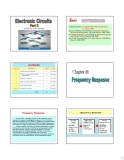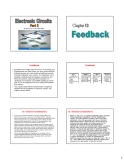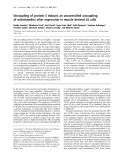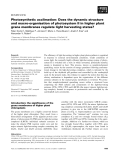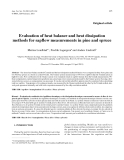
Heat dissipation
-
The reader may wonder why the amplifier stages studied in previous chapters are not suited to high-power applications. Suppose we wish to deliver 1 W to an 8- speaker. Approximating the signal with a sinusoid of peak amplitude VP, we express the power absorbed by the speaker as:
 82p
82p  vanmanh1008
vanmanh1008
 23-05-2013
23-05-2013
 49
49
 7
7
 Download
Download
-
The need for operating circuits at increasingly higher speeds has always challenged designers. From radar and television systems in the 1940s to gigahertz microprocessors today, the demand for pushing circuits to higher frequencies has required a solid understanding of their speed limitations. In this chapter, we study the effects that limit the speed of transistors and circuits, identifying topologies that better lend themselves to high-frequency operation.
 25p
25p  vanmanh1008
vanmanh1008
 23-05-2013
23-05-2013
 69
69
 4
4
 Download
Download
-
Sufficient heat dissipation is crucial to the effective operation of friction based braking systems. Such cooling is generally provided by ensuring a sufficient supply of cooling air to the heated components, hence the aerodynamics in the region of the brake components is extremely important. The objective of the research was to develop an understanding of how aerodynamics could be used to improve the cooling of automotive disc brakes.
 137p
137p  runthenight07
runthenight07
 01-03-2023
01-03-2023
 12
12
 3
3
 Download
Download
-
Main points of thesis: Fabrication of the carbon nanotube based internal combustion engine oils; measurement, characterization of CNTs-based oils regarding their structures, physical, thermal, and electrical properties; heat dissipation modeling and thermal-conductivity computation of the carbon nanotube based internal combustion engine oils, and comparison with the experimental results.
 23p
23p  xacxuoc4321
xacxuoc4321
 09-07-2019
09-07-2019
 32
32
 4
4
 Download
Download
-
Feedback is an integral part of our lives. Try touching your fingertips with your eyes closed; you may not succeed the first time because you have broken a feedback loop that ordinarily “regulates” your motions. The regulatory role of feedback manifests itself in biological, mechanical, and electronic systems, allowing precise realization of “functions.” For example, an amplifier targeting a precise gain of 2.00 is designed much more easily with feedback than without.
 16p
16p  vanmanh1008
vanmanh1008
 23-05-2013
23-05-2013
 47
47
 4
4
 Download
Download
-
The uncoupling proteins (UCPs) are thought to uncouple oxidative phosphorylation in the mitochondria and thus generate heat. One of the UCP isoforms, UCP3, is abun-dantly expressed in skeletal muscle, the major thermogenic tissue in humans. UCP3 has been overexpressed at high levels inyeast systems,where it leads to theuncouplingof cell respiration, suggesting that UCP3may indeed be capable of dissipating the mitochondrial proton gradient.
 9p
9p  research12
research12
 29-04-2013
29-04-2013
 40
40
 3
3
 Download
Download
-
The efficiency of light harvesting in higher plant photosynthesis is regulated in response to external environmental conditions. Under conditions of excess light, the normally highly efficient light-harvesting system of photo-system II is switched into a state in which unwanted, potentially harmful, energy is dissipated as heat.
 11p
11p  media19
media19
 06-03-2013
06-03-2013
 45
45
 4
4
 Download
Download
-
Abstract – The tissue heat-balance method (Cÿermák) and the heat-dissipation method (Granier) were compared in three Scots pines and two Norway spruces in a forest in central Sweden. The Granier system measured up to 50% lower sapflow than the Cÿermák system at high flow rates.
 14p
14p  toshiba6
toshiba6
 05-10-2011
05-10-2011
 66
66
 3
3
 Download
Download









